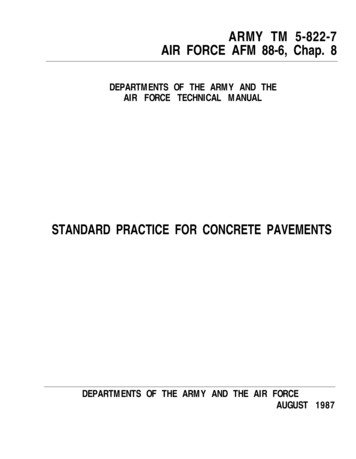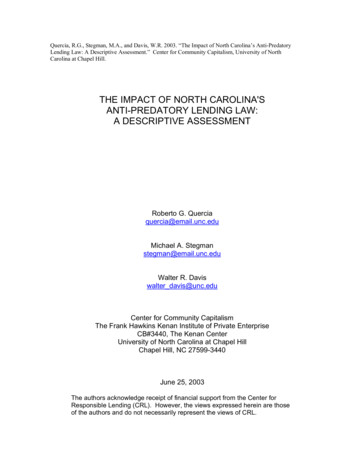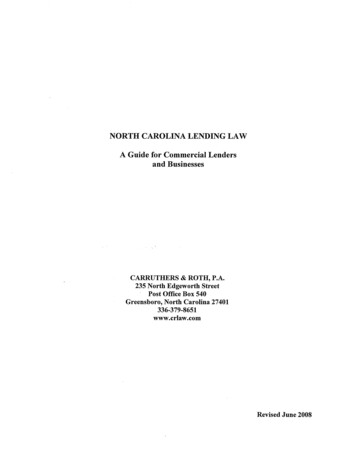
Transcription
Maintaining Permeable PavementsINTENDED FUNCTION ANDBENEFITS OF MAINTENANCEtion as intended, however, inspection andconsequent maintenance are imperative.Research studies and anecdotal case studies from across the USA and the worldhave shown that permeable pavementssubstantially and significantly reducerunoff volumes, limit peak flows, andsequester (trap) many types of pollutants. Many permeable pavements furtherimprove ground water recharge, have highalbedo (light reflectivity), reduce runofftemperature, and improve aesthetics.Permeable pavements are able to achievethis by allowing water to pass through thesurface layer and temporarily collect inunderlying aggregate storage layers. Thiswater then either is released back to thestorm drain system through underdrainsor infiltrates into the underlying soil, or acombination of both. A small fraction ofrunoff will evaporate or evapotranspire.To enable permeable pavements to func-TYPES OF PERMEABLEPAVEMENTSFor the purposes of this bulletin, anypavement that is intended to let water passthrough its surface and temporarily collectin an underlying aggregate storage zoneis termed permeable pavement. However,among this broad definition of pavement,there are several specific types. Several ofthese types are pictured in Figure 1 below.For specific details of each pavementtype, please see AG-588-14W (PermeablePavement: Research Update and DesignImplications).Permeable concrete (PC) is a mixture of Portland cement, fly ash, washedgravel, and water. Permeable asphalt (PA)consists of fine and course aggregate stonebound by a bituminous-based binder. WaterFigure 1. Types of permeable pavement. Top L-R: Permeable concrete (PC), permeable asphalt (PA),permeable interlocking concrete pavers (PICP). Bottom L-R: concrete grid pavers (CGP), plastic reinforcing grids (PG) filled with gravel, and PG with grass.
passes through interconnected pores in both PC and PA.Permeable interlocking concrete pavements (PICP) areavailable in many different shapes and sizes. When laid,the blocks form patterns that create openings throughwhich rainfall can infiltrate. Concrete Grid Pavers(CGP) are an “older cousin” to PICP and have relativelylarger open areas that are filled with gravel, sand, or evena loamy sand top soil. Plastic reinforcement grid pavers (PG), also called geocells, consist of flexible plasticinterlocking units that allow for infiltration through largegaps filled with gravel or topsoil planted with turfgrass.A sand bedding layer and (more frequently) gravel basecourse are often added to increase infiltration and storagefor many of these paver systems.All permeable pavement types must be inspected andmaintained. There are certain elements of maintenancethat are common among permeable pavements and otherelements that are specific to one or two pavement types.DESIGNING AND CONSTRUCTING WITHMAINTENANCE IN MINDProper design can help avoid future maintenance problems. Typically, the most common permeable pavementperformance concern is clogging. Pavements must allowwater to pass through their surface to be permeable.Designers can minimize the likelihood of clogging byconsidering the two most likely clogging sources: vegetative litter and sediment.Parking lots with overhanging trees provide manybenefits: shading to cool pavement temperature andimproved aesthetics are obvious reasons to landscapeparking lots with trees and shrubs. Designers must beaware, however, of unintended consequences associatedwith a leaf canopy overhanging a permeable application. Vegetation debris and detritus collect in perme-able pavement water pathways, rendering them muchless permeable. This has been anecdotally observed atseveral permeable pavement applications across theU.S. (Figures 2 and 3). After the tree detritus falls on tothe permeable pavement, it risks being ground into thepavement by passing vehicle tires. Large parking lotsthat are fringed by trees have had their perimeters clog,but the middle portions did not clog (Figure 2). Whilethe purpose of this chapter/bulletin is not to dissuadedesigners from incorporating vegetation in the parkinglot, designers do need to be mindful that any pavementunderneath a tree canopy is at a much higher risk ofclogging than pavement free and clear of vegetation.Sediment accumulation from disturbed areas surrounding the permeable pavement is the most frequentcause of permeable pavement failure. Designers musttake special care to inform contractors to minimizeexposure of permeable pavement to sediment duringconstruction. Permeable pavements in residential areasare particularly at risk. As one home is completed, anadjoining property may remain under construction. Inthese cases, the likelihood of sediment deposition fromwind, water, and tires is very high (Figure 3).LANDSCAPE MAINTENANCE ACTIVITIES:AVOIDING PROBLEMSProperty owners often incorporate landscape maintenance as part their property upkeep. Common activitiesinclude re-mulching and lawn mowing with dischargeof clippings. An uninformed landscaper may deposit hismulch pile on the pavement immediately adjacent to thelandscape bed he is beautifying or may discharge grassclippings onto the pavement. If that pavement is permeable, a clogging source has just been introduced. Aneasy way to avoid this issue is either to bag clippings orplace the mulch pile ona tarp that can be carefully removed to preventclippings or mulch fromfalling onto the permeable pavement.In locations withsnowfall, plowing is anecessary maintenanceactivity that can havean impact on permeable pavement function.When non-spec (unscreened and unwashed)Figure 2. Leaf and tree detritus collects in pathsand (meant for vehicleways intended for water in PICP located underneath a tree line outside Chicago, IL.traction, not permeablepavement infiltration) is2Urban Waterways
Figure 3. Residential construction increases the likelihood of sediment accumulation in permeable pavements (left). A pervious asphalt pavement near Philadelphia, PA, is clogged due to runoff from an adjoining area that was not stabilized (right).placed upon snow and ice and is later plowed to a location that drains to or on top of permeable pavement, aclogging source is introduced to the pavement. Either(1) preventing the stockpiling of snow on permeablepavement or (2) requiring post-event street sweepermaintenance (discussed later) are two options of limiting winter weather induced clogging.PRIMARY INSPECTION AND MAINTENANCETASKSPermeable pavement maintenance is rather straightforward when compared to other stormwater managementpractices (such as bioretention, wet ponds, and stormwater wetlands). The common inspection and maintenancetasks are: (1) verifying that clogging has not occurred,(2) preventive street sweeping, (3) weeding, and (4) stainremoval. Additionally, some pavement type-specific tasksinclude: (1) restorative street sweeping and (2) mowing.Each of those inspection and maintenance activitiesis discussed in more detail.InspectionRegular inspection is an essential part of permeablepavement maintenance. During the visit the pavement’s surface can be examined for accumulated dust,sediment, and debris (Figure 4). A simple test to verifywhether the pavement is infiltrating properly is toempty a bucket or large bottle of water on the pavement and examine how long it takes for water to soakthrough the pavement and the “water mark” that is left.Pavements that require from several seconds to min-Figure 4. Visual inspection of a pervious concrete lot in Georgia shows accumulation of both sediment and leaf debris (left).The fact that the lot is clogged is confirmed by emptying approximately 1 gallon of water on the lot, which subsequentlyruns off rather than infiltrating (right).Maintaining Permeable Pavements3
utes for the water to stop flowing are clogged to somedegree (Figure 4).During the site visit, the inspector can scout forweed growth and trash deposition. If the permeablepavement is underdrained, the underdrain outlet shouldbe checked to verify it is not blocked. If the visit occursafter a storm, a trickle of water would be expected fromthe underdrain.STREET SWEEPINGStreet sweeping is the most important maintenance taskassociated with permeable pavement. Street sweepingcan serve one of two purposes: preventive maintenanceand restorative maintenance. Preventive street sweepingis preferred. Preventive sweeping is regular, scheduledpasses by a street sweeper during a calendar year. Whilethe exact frequency has yet to be determined, it appearstwo to four visits per year for most permeable pavementapplications is sufficient. If the permeable pavement hasbeen neglected for several years, however, preventivemaintenance will not be sufficient, so restorative streetsweeping will be required to restore a pavement’s ability to infiltrate water. The type of equipment needed toachieve either preventative maintenance or restorativemaintenance is not the same.Types of Street SweepersThere are three main classes of street sweepers: (1)mechanical, (2) regenerative air, and (3) vacuum. Examples of mechanical and vacuum sweepers are shown inFigure 5.Mechanical street sweepers are the most common street sweeper on the market. By some accounts,approximately 70 percent of street sweepers in the U.S.are mechanical street sweepers (Mark Kinter1). Mechanical sweepers employ a multiple brush approach to firstmove sediment and trash to the middle and then lift thedeposits onto a conveyor belt for temporary storage. Thebrush bristles can penetrate some types of permeablepavements, but not most.Regenerative air street sweepers are the second mostcommon street sweeper, accounting for roughly 20 percent of street sweepers in use in the U.S. They work byshooting air at an angle to the pavement, which effectively loosens dust and other fine particles at and nearthe surface of the pavement. Because air is blown acrossthe carriage of the truck, a relatively minor vacuum iscreated, which then lifts the loosened particles into ahopper. This system removes surface-deposited sediments from all pavement types.Vacuum street sweepers are the least common andmost expensive type of sweepr, and account for 104Urban WaterwaysFigure 5. A small mechanical street sweeper (top) and theunderpinnings of a vacuum sweeper (bottom).percent of street sweepers in the U.S. They function byapplying a strong vacuum to a relatively narrow areathat lifts particles both at and below the surface of thepavement. Vacuum sweepers have demonstrated theirability to suction 3 to 4 inches of gravel from PICP andhave the ability to restore infiltration to some types ofpavements that have been grossly neglected.Where do permeable pavements clog?Permeable pavement systems clog at different locationsin their cross-section. Because of this, not one type ofstreet sweeper is recommended for all types of permeable pavements. Based upon anecdotal observationand research, here are the observed zones or depths ofsurface clogging.Concrete grid pavers, because their gaps are filledwith sand, act like a sand filter and trap most of the fineMr. Kinter is an Elgin Street Sweeper marketing director. Conversation took place in May 2009.1
Figure 6. Mechanical sweeper bristle penetration of larger gaps associated with CGP filled with sand (left) is possible, butpavement types with small gaps (such as PICP) is not (right, courtesy of Elgin Street Sweepers).sediment at theirsurface. The thinclogged zone isnamed “schmutzdecke” from theGerman word fordirt cover or ceiling.The thickness of theschmutzdecke forCGP ranges from0.25 to 0.50 inches(James and Gerrits2003, Bean et al.2007). As the gapsassociated with CGPare the largest of allpermeable pavementtypes, CGP is theFigure 7. The clogged zone of PICP isevident toward the top portion of the easiest to maintaininterlocking paver. The depth of clog- with a mechanicalging at this location outside Chicago, sweeper. By basicIL, after 6 years of neglect was 1.5geometry, the abilityinches (40mm).of bristles to penetrate a large gap to a deeper depth benefits CGP (Figure6). Research has shown that a standard mechanicalstreet sweeper can sufficiently penetrate the sand-filledgaps of CGP to break apart the schmutzdecke.Dust and sediment will penetrate PICP filled withgravel to a much deeper level than that of CGP filled withsand. Field observation at a lot outside Chicago foundthat a 6-year-old PICP lot that had never been maintained had become clogged to a depth of 1.5 to 2.0 inches(Figure 7). Removing a schmutzdecke of this thicknessis clearly beyond the ability of a standard mechanicalsweeper. In fact, regenerative air street sweepers are con-sidered insufficient for this restorative measure.Clogging depth of pervious asphalt and perviousconcrete depends upon the contributing sediment load.Research has shown that sand collected on a perviousconcrete pavement will not penetrate the pavement morethan an inch deep. Although pervious asphalt was nottested, it is assumed it would function similarly. However, when a fine fraction of soil (silts or clays) was apart of the clogging sediment, the clogged zone wasmuch deeper, often at or near the bottom of the perviousconcrete section (Mata 2008). Restorative maintenanceof a PA or PC system clogged by fines has not yet beendeemed possible. However, preventative maintenance,by way of a regenerative air street sweeper, has provento be an adequate measure and keeps PA and PC surfaces infiltrating rainfall and run-on.Table 1 summarizes the clogging depth of various types of permeable pavements and the appropriatevehicle for prevention or restoration. Obviously, thesimplest pavement type to either maintain or restoreis concrete grid pavers filled with sand. All pavement types can remain clog-free if preventive sweepermaintenance is reliably provided. If pavements areneglected and allowed to clog to sometimes substantialdepths, it is uncertain whether all pavements’ necessary surface infiltration rates can be restored. Alsoimportant to note, other than for CGP filled with sand,different street sweeper types are used for either preventive or restorative maintenance.Importance of Underlying Soil TypeBean et al. (2007) showed that even when maintenance(street sweeping) has been neglected for up to 20 years,permeable pavements can still be permeable, provided theunderlying soils are permeable. Several tests of relaMaintaining Permeable Pavements5
Table 1. Street sweeper assignment to various permeable pavementsPavement TypeSchmutzdecke DepthPreventive SweeperRestorative SweeperConcrete Grid Pavers filled with sand0.5 inchesMechanicalMechanicalPICP filled with aggregate1.5 to 2.0 inchesRegenerative AirVacuumPervious concretePervious asphaltIf Sand: 1 inchIf Silt/Clay: 3 inchesIf Sand: 1 inchIf Silt/Clay : 3 inchesRegenerative AirRegenerative AirIf Sand: Vacuum?If Silt/Clay: Not knownIf Sand: Vacuum?If Silt/Clay: Not knowntively old permeable pavements located along the NorthCarolina barrier islands and in the NC sandhills, bothvery sandy soil regions, demonstrated that despite beingclogged, infiltration rates usually exceeded 1 in/hr. Thisis because the pavement was clogged by sand. Designersand regulators should consider whether an infiltration rateof 1 to 2 inches per hour is acceptable. If so, the frequency of required street sweeping in some (albeit limited)parts of the U.S. is reduced. A recent analysis of rainfallintensities in NC demonstrated that less than 2 percent ofall rainfall intensities (as measured hourly) exceed 1 in/hr.PICP related specificsStreet sweepers will remove fill aggregate that couldthen pose a tripping hazard (Figure 8). So every timePICP is machine swept, aggregate refill is mandatory(Figure 8). Be mindful that not every aggregate maybe appropriate for the landowner and application. Theaggregate’s color or hue and that of the PICP blockcould be important to the landowner. Refilling gaps isa very easy process and is usually achieved by broomsweeping.Vacuum sweepers are powerful and, if not carefullyoperated, can suction too much aggregate from the gapsand beneath the pavers. Care must be taken to verify thatthe amount of suction provided by the vacuum sweeper isnot removing portions of the gravel base layer. This canbe quickly checked by sticking a pencil down the vacuumed gap to verify the depth of gravel suctioned is lessthan the depth of the block.OTHER MAINTENANCE ISSUES: REMOVINGUNWANTED VEGETATIONVegetation is often a sign that too much sediment hasaccumulated, because the excess sediment provides anenvironment for vegetation to survive. Weeds should beremoved using a systemic herbicide such as glyphosateand then returning within the week to pull the weeds.It is imperative to not let unwanted vegetation persist.As weeds mature, it becomes harder to remove the root6Urban WaterwaysFigure 8. PICP gaps must be filled with aggregate toprevent a tripping hazard (top). Gravel replacement issimple and done with a push broom (bottom).structure, and its removal can be more destructive to thestructure of the pavement.One cautionary note: some permeable applicationsare meant to be grassed. Mowing may actually be theappropriate maintenance activity. If a parking lot is tobe mowed, please remember to catch the grass clippingsbefore they are deposited on the pavement. Accumulation of grass biomass (clippings) could further limitinfiltration.
Figure 9. A stain remover applied to PICP (left) and subsequent pressure washing (right). Ideally, the stain remover isallowed to set overnight.Table 2. Summary Table of PP Maintenance. Maintenance tasks deemed essential to the hydrologic performanceof the device are in bold italics.TaskFrequencyNotes and DriversInspectionTwo-three monthsAvoid significant clogging by observation.Street Sweeping (preventative)2 to 4 times a yearUsing a regenerative air street sweeper for most pavements is appropriate.Stain RemovalPer client desiresStains may be tolerated. If stain must be removed, consider a biodegradable detergent.Weed removalDo upon inspectionUse glyphosate.MowingIn high season 1-2 timesper monthSome permeable pavement applications are meant to be mowed.Do vegetated pavements have higher infiltrationthan non-vegetated permeable pavements?There are two ways to answer this question. Permeable applications that are not intended tobe vegetated (like PICP filled with gravel, pervious concrete, and pervious asphalt) and thatare working as intended will have much higher infiltration rates than purposefully vegetated permeable lots. This is due to the lack of fines collected in the former. However, a lotthat without vegetation and with sediment accumulated in pavement gaps probably has alower infiltration rate than a lot with vegetation, because the grass roots facilitate water flowthrough the soil media. Were permeable applications to be ranked by permeability the following hierarchy would apply: Unclogged PICP with aggregate fill, PC, PA — Highest Pavement with sediment accumulation with vegetation — Much Lower Pavement with sediment accumulation without vegetation — LowestDesigners should remember that when a grassed permeable pavement application is specified, the designer is sacrificing infiltration for aesthetics.Maintaining Permeable Pavements7
NC STATE UNIVERSITYOIL AND GREASE STAINSCan you live with them? Many permeable pavementapplications are along parking lot perimeters, and theclient may be comfortable with simply allowing thepavements to slowly stain. Clearly, pervious asphaltdoes not show stains as much as other pavement types.A designer has the option of selecting pavement typesthat camouflage stains better than others. However, thesame pavement types that are good at hiding stains alsohave low albedo, which conflicts with another driverfor the use of permeable pavement. (Designers choosehigh albedo pavements to comply with LEED 2 lightreflectivity goals.)Can you remove stains? There are detergents, suchas Pour-N-Restore , that can be used to partiallyremove stains. They are applied to the stain and allowedto soak. The following day, the soap is pressure washedfrom the blocks (Figure 9). The majority of stain isremoved, but inspection will show a watermark fromwhere the stain had been.SUMMARYDesigners choose permeable pavements because theyreduce runoff volume, mitigate runoff peaks, and sequester many forms of pollution. They may also provideother benefits like groundwater recharge, minor evapotranspiration losses, light reflectivity (albedo), and visualimprovement. For permeable pavements to remainpermeable, their surface layer must be freely draining,making clogging prevention and street sweeping themost important tasks associated with inspection andmaintenance. Although not necessarily inexpensive, permeable pavement maintenance is very straightforward.Other tasks that maintenance professionals should consider include stain removal, weed removal, and in somecases mowing. The exact maintenance tasks will vary bypermeable pavement type and intended function.REFERENCESBean, E. Z., W.F. Hunt, and D.A. Bidelspach. (2007).Field survey of permeable pavement surface infiltration rates. Journal of Irrigation and Drainage Engineering. 133 (3): 247-255.James, W. and C. Gerrits. (2003). Ch 21: Maintenanceof Infiltration in Modular Interlocking Concrete Pavers with External Drainage Cells. In Practical Modeling of Urban Water Systems, Mono, 11. 417-435 W.James, ed. Guelph, Canada: CHI.Mata, L.A. (2008). Sedimentation of Pervious ConcretePavement Systems. Ph.D. Dissertation. North Carolina State University. Raleigh, NC.Related Bulletins in the Urban Waterways (AG-588)Series:Hunt, W.F. and K.A. Collins. 2008. Permeable Pavement: Research Update and Design Implications.North Carolina Cooperative Extension, Raleigh, NC.AG-588-14W.Leadership in Energy and Environmental Design, an effort of the USGreen Building Council.2Prepared byWilliam F. Hunt, Ph.D., PE, Associate Professor and Extension Specialist,Biological and Agricultural Engineering Department, North Carolina State UniversityPublished byNORTH CAROLINA COOPERATIVE EXTENSIONDistributed in furtherance of the acts of Congress of May 8 and June 30, 1914. North Carolina State University and North Carolina A&T State University commit themselves to positive action tosecure equal opportunity regardless of race, color, creed, national origin, religion, sex, age, veteran status or disability. In addition, the two Universities welcome all persons without regard to sexualorientation. North Carolina State University, North Carolina A&T State University, U.S. Department of Agriculture, and local governments cooperating.12-CALS-2353AG-588-23 W8/11—VB/KEL
Maintaining Permeable Pavements 3 placed upon snow and ice and is later plowed to a loca-tion that drains to or on top of permeable pavement, a










